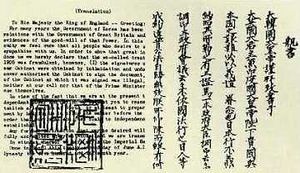Japan-Korea Annexation Treaty Of 1907
 From Conservapedia
From Conservapedia The Japan-Korea Annexation Treaty of 1907 (Japanese: 第三次日韓協約 Dai-sanji Nikkan Kyōyaku Korean: 정미7조약 Jeongmi joyak), also known as the "Third Korea-Japan Agreement", was signed between the Empires of Japan and Korea on 24 July 1907.
Contents
- 1 Background
- 2 Text of the Treaty
- 3 Text of the Unpublished Diplomatic Memorandum
- 4 See also
- 5 References
Background[edit]

Emperor Gojong, in attempt to alert the international community of Japan's attempts to colonise Korea, secretly dispatched a number of emissaries to the Second Hague Conference on World Peace (15 June to 18 October 1907). They attempted to present various world leaders with a letter from the Emperor, refuting the terms of the Eulsa Treaty, but they were refused entry to the conference.
When the Japanese learned of this, they, via the Office of the Resident-General, Itō Hirobumi, forced Emperor Gojong to abdicate the throne in favour of his son, Sunjong.
The treaty allowed large number of Japanese officials to penetrate the executive and judicial branches of the Korean government, thus accelerating the scheme to fully colonise Korea. The Korean armed forces were disarmed and disbanded and the judicial system was reorganized to serve Japanese needs.
Moreover, in a secret memorandum attached to the Korean-Japan agreement, it was stipulated that Korean military forces would be dissolved and that courts, newly constructed prisons, and the police would be turned over to Japanese management. This enabled the Japanese to assume actual judicial and police authority.
Text of the Treaty[edit]
| “ | The Governments of Japan and Korea, with a view to the early attainment of prosperity and strength in Korea and the speedy promotion of the welfare of the Korean people, have agreed upon and concluded the follow stipulations:
Itō Hirobumi, Resident-General, July 24th, 40th year of the Meiji era [1907] (seal) |
” |
Text of the Unpublished Diplomatic Memorandum[edit]
| “ | Based on the import of the Japan-Korea treaty of the 40th year of the Meiji era, the following items shall be enacted.
(1) The following courts, composed of people from both Japan and Korea, shall be newly established: 1. One Supreme Court located in Gyeongseong Seoul or Suwon. The President and Attorney General of the Court shall be Japanese. Two of the Justices and five of the secretaries shall be Japanese. 2. Three Courts of Appeal One shall be located in the central region, and one each in the northern and southern regions. Two of the Justices, one of the attorneys and five of the secretaries shall be Japanese. 3. Eight District Courts One of these shall be located at each of the locations of the prosecutor's offices in the eight former provinces. The chief prosecutors and head attorneys shall be Japanese. 32 of all attorneys and 80 of all secretaries shall be Japanese, and shall be allocated as appropriate given the degree of work required. 4. 103 Ward Courts Thesе are to be located in the locations of important regional offices. One of the attorneys and one of the secretaries is to be Japanese. (2) The following prisons shall be newly established. 1. Nine prisons One prison shall be located in the same area as each of the district courts, and one prison on one of the islands. The governor shall be Japanese. Half the prison staff, consisting of the head warden and levels below, shall be Japanese. (3) Military forces shall be arranged as follows.
(4) All those currently in the service of Korea with the position of adviser or parliamentary councilor shall be removed from their duties. (5) The following Japanese shall be appointed as officials in the Korean central government and local authorities:
The matter of other appointments of Japanese as officials in the areas of finance, policing and technology shall be set down by a later agreement.[1] |
” |
See also[edit]
- Protectorate Treaty of 1904
- Eulsa Treaty
- Japan Korea Annexation Treaty
- Treaty on Basic Relations between Japan and the Republic of Korea
References[edit]
- ↑ http://www.jacar.go.jp/english/nichiro/19070724.htm
- Russo-Japanese War and Japanese Extortion of Korea’s Sovereignty
- Korean Colonisation
Categories: [Japanese Treaties] [Korea]
↧ Download as ZWI file | Last modified: 02/25/2023 10:21:32 | 5 views
☰ Source: https://www.conservapedia.com/Japan-Korea_Annexation_Treaty_of_1907 | License: CC BY-SA 3.0
 ZWI signed:
ZWI signed: KSF
KSF